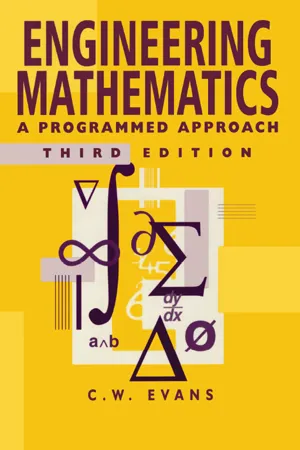Mathematics
Integrating Even and Odd Functions
Integrating even and odd functions involves finding the definite integral of a function over a symmetric interval. For even functions, the integral over a symmetric interval is twice the integral over half the interval. Odd functions have a zero integral over a symmetric interval. This concept is useful for simplifying integration problems and understanding the properties of functions.
Written by Perlego with AI-assistance
Related key terms
Related key terms
1 of 4
Related key terms
1 of 3
4 Key excerpts on "Integrating Even and Odd Functions"
- eBook - ePub
Engineering Mathematics
A Programmed Approach, 3th Edition
- C W. Evans(Author)
- 2019(Publication Date)
- Routledge(Publisher)
21.1). Fig. 21.1: An odd function Suppose f (x) is defined on the interval − π ⩽ x ⩽ π, then f is said to be an even function if f (− x) = f (x) whenever − π ≤ x ≤ π Here are a few examples of even functions: l, x 2, cos x, cosh x. Even functions are easily recognized by their graphs; they are symmetrical about the y -axis (Fig. 21.2). Fig. 21.2: An even function In fact the identity f (x) ≡ [ f (x) + f (− x) 2 ] + [ f (x) − f (− x) 2 ] shows that every function f defined on the interval (− π, π) can be regarded as the sum of an even function and an odd function. In the previous example we found a trigonometrical series corresponding to an odd function and it had one curious feature. Did you notice what it was? There were no cosine terms whatever. We went through the motions of calculating the Fourier coefficients a n only to find they were all zero. Was this a coincidence or is there something deeper here? Let us suppose that f (x) = a 0 2 + ∑ r = 1 ∞ { a r cos r x + b r sin r x } and that f is an odd function on the interval (− π, π). We have already derived formulae for the Fourier coefficients and we. have a n = 1 π ∫ − π π f (x) cos n x d x b n = 1 π ∫ − π π f (x) sin n x d x Therefore a n = 1 π ∫ − π π f (x) cos n x d x = 1 π { ∫ − π 0 f (x) cos n x d x + ∫ 0 π[--=PLGO-SEPARATO. R=--]f (x) cos n x d x } Putting t = −x in the first integral and using f (− t) = − f (t) we. obtain a n = 1 π { ∫ π 0 f (− t) cos (− n t) (− d t) + ∫ 0 π f (x) cos n x d x } = 1 π { ∫ π 0 f (t) cos n t d t + ∫ 0 π f (x) cos n x d x } = 1 π { ∫ 0 π f. (t) cos n t d t + ∫ 0 π f (x) cos n x d x } Observe that t is a dummy variable in the first integral just as x is a dummy variable in the second. Consequently these two integrals are equal and so cancel one another out. Therefore we have shown that for an odd function a n = 0. Moreover we can use the same idea to simplify slightly the formula for b n in the case of an odd function - eBook - ePub
- Colin Beveridge(Author)
- 2016(Publication Date)
- For Dummies(Publisher)
?An even function is anything you can write using only even powers; an odd function is anything you can write with only odd powers. (Some functions – in some sense, most functions – are neither even nor odd.)However, some functions are even or odd without it being obvious you can write them in the appropriate form: and happen to be odd functions, while is even. Looking at the graphs of a few of these functions gives you an idea of what it might mean to be odd or even – see Figure 9-6 .© John Wiley & Sons, Inc.Figure 9-6: Some (a) even and some (b) odd functions.An even function has reflective symmetry in the y -axis; an odd function has rotational symmetry about the origin. There’s a more formal definition, though:- If for all x , the function has reflective symmetry in the y -axis, so f is an even function.
- If for all x , the function has rotational symmetry about the origin, so f is an odd function.
- If neither of these conditions holds, then the function is neither even nor odd.
Numerical Methods
I know, I’ve been banging on for the whole of the book about how exact answers are brilliant, and you should always use fractions, and decimals are evil. There’s one topic where that’s not true: numerical methods.The thing is, not every mathematical problem has an answer you can write down exactly (except by cheating – for example, by defining a constant to be the unknown number you want). In these cases, it makes sense to come up with decimal approximations rather than just shrugging and saying, ‘There’s no answer.’This is straying dangerously into the world of computer maths, which, obviously, Ofqual insists you attempt without a computer, in the same way that driving tests should be done without a car. No, hang on – that would be ridiculous. Forget I said anything. - eBook - ePub
Differential Equations
A Modern Approach with Wavelets
- Steven Krantz(Author)
- 2020(Publication Date)
- Chapman and Hall/CRC(Publisher)
interior point, and also that f (x +) exists at the left endpoint and f (x −) exists at the right endpoint. [ Hint: Each interior point of discontinuity is isolated from other such points, in the sense that the function is continuous at all nearby points. Also, on each side of such a point and near enough to it, the function does not oscillate; it is therefore increasing or decreasing.] 6.3 Even and Odd Functions: Cosine and Sine Series A function f is said to be even if f (− x) = f (x). A function g is said to be odd if g (− x) = − g (x). FIGURE 6.12 An even and an odd function. EXAMPLE 6.3.1 The function f (x) = cos x is even because cos(− x) = cos x. The function g (x) = sin x is odd because sin(− x) = − sin x. ■ The graph of an even function is symmetric about the y -axis. The graph of an odd function is skew-symmetric about the y -axis. Refer to Figure 6.12. If f is even on the interval [− a, a ] then ∫ − a a f (x) d x = 2 ∫ 0 a f (x) d x (6.3.1) and if f is odd on the interval [− a, a ] then ∫ − a a f (x) d x = 0. (6.3.2) Finally, we have the following parity relations (even) ⋅ (even) = (even) (even) ⋅ (odd) = (odd) (odd) ⋅ (odd) = (even). Now suppose that f is an even function on the interval [− π, π ]. Then f (x) · sin nx is odd, and therefore b n = 1 π ∫ − π π f (x) sin n x d x = 0. For the cosine coefficients, we have a n = 1 π ∫ − π π f (x) cos n x d x = 2 π ∫ 0 π f (x) cos n x d x. FIGURE 6.13 Periodic extension of f (x) = | x |. Thus the Fourier series for an even function contains only cosine terms. By the same token, suppose now that f is an. odd function on the interval [− π, π ] - eBook - ePub
- Dingyü Xue(Author)
- 2020(Publication Date)
- De Gruyter(Publisher)
polar() is the same, however, it is not recommended.Example 2.14.
Draw the curve of the polar functionρ =.esin 4 θ− 0.1 θSolutions.
Letting the independent variable θ vary in the intervalθ ∈ ( 0 , 10 π ), the vectors can be generated, and the polar plot can be obtained, as shown in Figure 2.7 .>> theta=0:0.001:10*pi; rho=exp(-0.1*theta).*sin(4*theta); polarplot(theta,rho)Figure 2.7 Polar plot.Many polar functions are periodic, i. e., within a cycle, a vector θ can be created, and the polar plot can be drawn. This function is not periodic, no matter how large the interval is chosen, the complete polar plot cannot be drawn.2.3 Odd and even functions
Definition 2.13.
Assume that a functionf ( x )is defined in the symmetric interval− L ⩽ x ⩽ L. Iff ( x ) = f ( − x ),f ( x )is referred to as an even function, while iff ( x ) = − f ( − x )thenf ( x )is an odd function.In fact, it is quite easy and straightforward to judge whether a function is even or odd in MATLAB. Iff ( x ) + f ( − x )andf ( x ) − f ( − x )are simplified, one can check which of them are zero. If the former is zero, thenf ( x )is odd, while if the latter is zero,f ( x )is even; if neither is zero, functionf ( x )is neither odd nor even. An example is given below to show the classification of a given function into odd or even.Example 2.15.
Judge the parity of functionf ( x ) =.1 + x +−x 21 − x +x 2Solutions.
The function can be entered in MATLAB, and the two expressions are simplified. It can be seen thatf ( x )is odd. Function fplot() can also be used to draw the curve of the function, as shown in Figure 2.8 . It is also seen from the figure thatf ( x )
Index pages curate the most relevant extracts from our library of academic textbooks. They’ve been created using an in-house natural language model (NLM), each adding context and meaning to key research topics.
Explore more topic indexes
Explore more topic indexes
1 of 6
Explore more topic indexes
1 of 4



